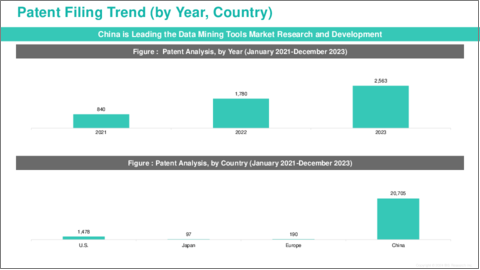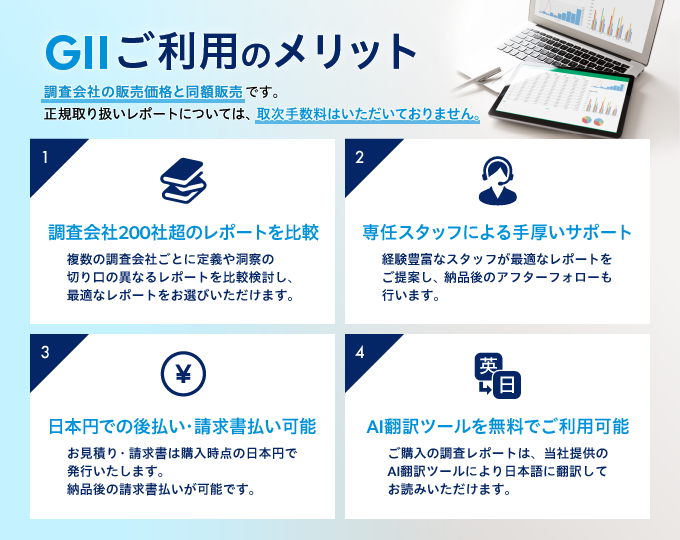|
|
市場調査レポート
商品コード
1507361
データマイニングツール市場 - 世界および地域の分析:最終用途・組織・展開タイプ・ビジネス機能・コンポーネント・地域別の分析・予測 (2024~2034年):Data Mining Tools Market - A Global and Regional Analysis: Focus on End-Use, Organization, Deployment Type, Business Function, Component, and Region - Analysis and Forecast, 2024-2034 |
||||||
カスタマイズ可能
|
|||||||
| データマイニングツール市場 - 世界および地域の分析:最終用途・組織・展開タイプ・ビジネス機能・コンポーネント・地域別の分析・予測 (2024~2034年): |
|
出版日: 2024年07月04日
発行: BIS Research
ページ情報: 英文 100 Pages
納期: 1~5営業日
|
全表示
- 概要
- 目次
データマイニングツールの市場はさまざま要因や市場促進要因に後押しされ、大きな成長を遂げています。
データマイニングツールの市場規模は、楽観的な予測では、2024年の12億4,000万米ドルから、予測期間中はCAGR 11.63%で推移し、2034年には37億3,000万米ドルの規模に成長すると予測されています。
| 主要市場統計 | |
|---|---|
| 予測期間 | 2024-2034年 |
| 2024年評価 | 12億4,000万米ドル |
| 2034年予測 | 37億3,000万米ドル |
| CAGR | 11.63% |
データ分析能力を強化し、情報に基づいた意思決定を推進する上での高度なデータマイニングツールの利点について、さまざまな業界で認識が高まっており、これが同市場の成長の主な要因となっています。高度なデータマイニングツールは、大規模で複雑なデータセットから貴重な知見を抽出する上で極めて重要な役割を果たし、企業は隠れたパターン、動向、相関関係を発見してビジネスを成功に導くことができます。
また、データ駆動型の意思決定への注目の高まりと、実用的な洞察の必要性が、さまざまな分野での高度なデータマイニングツールの採用を後押ししています。競合上の優位性を獲得し、業務効率を改善するためのデータへの依存度が高まる中、多様なデータタイプを扱い、正確でタイムリーな考察を提供できる高度なデータマイニングソリューションへの需要が高まっています。
さらに、データマイニングアルゴリズムや技術における継続的な技術の進歩やイノベーションも、市場拡大の原動力となっています。データマイニングツール分野の主な企業であるMicrosoft、IBM、Oracle などは、企業の進化するニーズに合わせた革新的なソリューションの開発をリードしています。データサイエンス、機械学習、アナリティクスの専門知識と顧客中心のアプローチが、データマイニングツール市場の情勢形成に役立っています。
当レポートでは、世界のデータマイニングツールの市場を調査し、業界の動向、技術・特許の動向、法規制環境、ケーススタディ、市場成長促進要因・抑制要因、市場規模の推移・予測、各種区分・地域/主要国別の詳細分析、競合情勢、主要企業のプロファイルなどをまとめています。
目次
エグゼクティブサマリー
第1章 市場:業界の展望
- 動向:現在および将来の影響評価
- サプライチェーンの概要
- バリューチェーン分析
- 価格予測
- R&Dレビュー
- 特許出願動向:国・企業別
- 規制状況
- ステークホルダー分析
- 使用事例
- エンドユーザーと購入基準
- 主要な世界的イベントの影響分析
- 市場力学の概要
- 市場促進要因
- 市場抑制要因
- 市場機会
第2章 データマイニングツール市場:用途別
- 用途の分類
- 用途の概要:最終用途別
- 小売
- 銀行・金融サービス・保険(BFSI)
- ヘルスケアとライフサイエンス
- 通信・IT
- 政府・防衛
- エネルギー・ユーティリティ
- 製造
- その他
- データマイニングツール市場:組織別
- 大企業
- 中小企業
- データマイニングツール市場:導入タイプ別
- オンプレミス
- クラウド
第3章 データマイニングツール市場:製品別
- 製品の分類
- 製品概要
- データマイニングツール市場:ビジネス機能別
- マーケティング
- ファイナンス
- サプライチェーンと物流
- オペレーション
- データマイニングツール市場:コンポーネント別
- ツール
- サービス
第4章 データマイニングツール市場:地域別
- データマイニングツール市場:地域別
- 北米
- 欧州
- アジア太平洋
- その他の地域
第5章 企業プロファイル
- 次なるフロンティア
- 地理的評価
- Microsoft
- MathWorks
- Teradata
- IBM
- SAS Institute
- Oracle
- H2O.ai
- Alteryx
- Intel
- Rapidminer
- SAP
- Knime
- Salford Systems
- FICO
- Blue Granite
- その他の主要企業
第6章 調査手法
Introduction to the Data Mining Tools Market
The data mining tools market is experiencing significant growth, fueled by various key factors and market drivers. In an optimistic projection, the market is expected to be valued at $1.24 billion in 2024, with an anticipated expansion at a CAGR of 11.63% to reach $3.73 billion by 2034.
| KEY MARKET STATISTICS | |
|---|---|
| Forecast Period | 2024 - 2034 |
| 2024 Evaluation | $1.24 Billion |
| 2034 Forecast | $3.73 Billion |
| CAGR | 11.63% |
A primary catalyst for this growth is the increasing recognition of the advantages offered by advanced data mining tools in enhancing data analysis capabilities and driving informed decision-making across different industries. Advanced data mining tools play a pivotal role in extracting valuable insights from large and complex datasets, enabling organizations to uncover hidden patterns, trends, and correlations that can drive business success.
Moreover, the escalating focus on data-driven decision-making and the need for actionable insights are propelling the adoption of advanced data mining tools in various sectors. With businesses increasingly relying on data to gain a competitive edge and improve operational efficiency, there is a growing demand for sophisticated data mining solutions that can handle diverse data types and provide accurate and timely insights.
Furthermore, continuous technological advancements and innovations in data mining algorithms and techniques are driving market expansion. Key players in the data mining tools sector, such as Microsoft, IBM, and Oracle are leading the development of innovative solutions tailored to the evolving needs of businesses. Their expertise in data science, machine learning, and analytics, coupled with a customer-centric approach, are instrumental in shaping the data mining tools market landscape.
In summary, the data mining tools market is witnessing robust growth, driven by the increasing recognition of its benefits, the growing demand for data-driven insights, and continuous technological advancements, all supported by the proactive efforts of industry leaders to deliver innovative solutions.
Market Segmentation:
Segmentation 1: by End-Use
- Retail
- Banking, Financial Services, and Insurance (BFSI)
- Healthcare and Life Sciences
- Telecom and IT
- Government and Defense
- Energy and Utilities
- Manufacturing
- Others
Segmentation 2: by Organization
- Large Enterprises
- Small and Medium-sized Enterprises (SMEs)
Segmentation 3: by Deployment Type
- On-premises
- Cloud
Segmentation 4: by Business Function
- Marketing
- Finance
- Supply Chain and Logistics
- Operations
Segmentation 5: by Component
- Tools
- Services
Segmentation 6: by Region
- North America
- Europe
- Asia-Pacific
- Rest-of-the-World
How can this Report add value to an Organization?
Product/Innovation Strategy: The global data mining tools market has been extensively segmented based on various categories, such as end-use, organization, business function, deployment type, and component. This can help readers get a clear overview of which segments account for the largest share and which ones are well-positioned to grow in the coming years.
Competitive Strategy: A detailed competitive benchmarking of the players operating in the global data mining tools market has been done to help the reader understand how players stack against each other, presenting a clear market landscape. Additionally, comprehensive competitive strategies such as partnerships, agreements, and collaborations will aid the reader in understanding the untapped revenue pockets in the market.
Key Market Players and Competition Synopsis
The companies that are profiled have been selected based on thorough secondary research, which includes analyzing company coverage, product portfolio, market penetration, and insights gathered from primary experts.
Some of the prominent companies in this market are:
- Microsoft
- IBM
- SAS Institute
- Oracle
- Teradata
- MathWorks
Key Questions Answered in this Report:
- What are the main factors driving the demand for data mining tools market?
- What are the major patents filed by the companies active in the data mining tools market?
- Who are the key players in the data mining tools market, and what are their respective market shares?
- What partnerships or collaborations are prominent among stakeholders in the data mining tools market?
- What are the strategies adopted by the key companies to gain a competitive edge in the data mining tools market?
- What is the futuristic outlook for the data mining tools market in terms of growth potential?
- What is the current estimation of the data mining tools market and what growth trajectory is projected from 2024 to 2034?
- Which application, and product segment is expected to lead the market over the forecast period (2024-2034)?
- Which regions demonstrate the highest adoption rates for data mining tools market, and what factors contribute to their leadership?
Table of Contents
Executive Summary
Scope and Definition
Market/Product Definition
Key Questions Answered
Analysis and Forecast Note
1. Markets: Industry Outlook
- 1.1 Trends: Current and Future Impact Assessment
- 1.2 Supply Chain Overview
- 1.2.1 Value Chain Analysis
- 1.2.2 Pricing Forecast
- 1.3 R&D Review
- 1.3.1 Patent Filing Trend by Country, by Company
- 1.4 Regulatory Landscape
- 1.5 Stakeholder Analysis
- 1.5.1 Use Case
- 1.5.2 End User and Buying Criteria
- 1.6 Impact Analysis for Key Global Events
- 1.7 Market Dynamics Overview
- 1.7.1 Market Drivers
- 1.7.2 Market Restraints
- 1.7.3 Market Opportunities
2. Data Mining Tools Market (by Application)
- 2.1 Application Segmentation
- 2.2 Application Summary
- 2.3 Data Mining Tools Market (by End-Use)
- 2.3.1 Retail
- 2.3.2 Banking, Financial Services, and Insurance (BFSI)
- 2.3.3 Healthcare and Life Sciences
- 2.3.4 Telecom and IT
- 2.3.5 Government and Defence
- 2.3.6 Energy and Utilities
- 2.3.7 Manufacturing
- 2.3.8 Others
- 2.4 Data Mining Tools Market (by Organization)
- 2.4.1 Large Enterprises
- 2.4.2 Small and Medium-sized Enterprises (SMEs)
- 2.5 Data Mining Tools Market (by Deployment Type)
- 2.5.1 On-premises
- 2.5.2 Cloud
3. Data Mining Tools Market (by Products)
- 3.1 Product Segmentation
- 3.2 Product Summary
- 3.3 Data Mining Tools Market (by Business Function)
- 3.3.1 Marketing
- 3.3.2 Finance
- 3.3.3 Supply Chain and Logistics
- 3.3.4 Operations
- 3.4 Data Mining Tools Market (by Component)
- 3.4.1 Tools
- 3.4.2 Services
4. Data Mining Tools Market (by Region)
- 4.1 Data Mining Tools Market (by Region)
- 4.2 North America
- 4.2.1 Regional Overview
- 4.2.2 Driving Factors for Market Growth
- 4.2.3 Factors Challenging the Market
- 4.2.4 Application
- 4.2.5 Product
- 4.2.6 U.S.
- 4.2.6.1 Market by Application
- 4.2.6.2 Market by Product
- 4.2.7 Canada
- 4.2.7.1 Market by Application
- 4.2.7.2 Market by Product
- 4.2.8 Mexico
- 4.2.8.1 Market by Application
- 4.2.8.2 Market by Product
- 4.3 Europe
- 4.3.1 Regional Overview
- 4.3.2 Driving Factors for Market Growth
- 4.3.3 Factors Challenging the Market
- 4.3.4 Application
- 4.3.5 Product
- 4.3.6 Germany
- 4.3.6.1 Market by Application
- 4.3.6.2 Market by Product
- 4.3.7 France
- 4.3.7.1 Market by Application
- 4.3.7.2 Market by Product
- 4.3.8 U.K.
- 4.3.8.1 Market by Application
- 4.3.8.2 Market by Product
- 4.3.9 Italy
- 4.3.9.1 Market by Application
- 4.3.9.2 Market by Product
- 4.3.10 Rest-of-Europe
- 4.3.10.1 Market by Application
- 4.3.10.2 Market by Product
- 4.4 Asia-Pacific
- 4.4.1 Regional Overview
- 4.4.2 Driving Factors for Market Growth
- 4.4.3 Factors Challenging the Market
- 4.4.4 Application
- 4.4.5 Product
- 4.4.6 China
- 4.4.6.1 Market by Application
- 4.4.6.2 Market by Product
- 4.4.7 Japan
- 4.4.7.1 Market by Application
- 4.4.7.2 Market by Product
- 4.4.8 India
- 4.4.8.1 Market by Application
- 4.4.8.2 Market by Product
- 4.4.9 South Korea
- 4.4.9.1 Market by Application
- 4.4.9.2 Market by Product
- 4.4.10 Rest-of-Asia-Pacific
- 4.4.10.1 Market by Application
- 4.4.10.2 Market by Product
- 4.5 Rest-of-the-World
- 4.5.1 Regional Overview
- 4.5.2 Driving Factors for Market Growth
- 4.5.3 Factors Challenging the Market
- 4.5.4 Application
- 4.5.5 Product
- 4.5.6 South America
- 4.5.6.1 Market by Application
- 4.5.6.2 Market by Product
- 4.5.7 Middle East and Africa
- 4.5.7.1 Market by Application
- 4.5.7.2 Market by Product
5. Companies Profiled
- 5.1 Next Frontiers
- 5.2 Geographic Assessment
- 5.2.1 Microsoft
- 5.2.1.1 Overview
- 5.2.1.2 Top Products/Product Portfolio
- 5.2.1.3 Top Competitors
- 5.2.1.4 Target Customers
- 5.2.1.5 Key Personnel
- 5.2.1.6 Analyst View
- 5.2.1.7 Market Share
- 5.2.2 MathWorks
- 5.2.2.1 Overview
- 5.2.2.2 Top Products/Product Portfolio
- 5.2.2.3 Top Competitors
- 5.2.2.4 Target Customers
- 5.2.2.5 Key Personnel
- 5.2.2.6 Analyst View
- 5.2.2.7 Market Share
- 5.2.3 Teradata
- 5.2.3.1 Overview
- 5.2.3.2 Top Products/Product Portfolio
- 5.2.3.3 Top Competitors
- 5.2.3.4 Target Customers
- 5.2.3.5 Key Personnel
- 5.2.3.6 Analyst View
- 5.2.3.7 Market Share
- 5.2.4 IBM
- 5.2.4.1 Overview
- 5.2.4.2 Top Products/Product Portfolio
- 5.2.4.3 Top Competitors
- 5.2.4.4 Target Customers
- 5.2.4.5 Key Personnel
- 5.2.4.6 Analyst View
- 5.2.4.7 Market Share
- 5.2.5 SAS Institute
- 5.2.5.1 Overview
- 5.2.5.2 Top Products/Product Portfolio
- 5.2.5.3 Top Competitors
- 5.2.5.4 Target Customers
- 5.2.5.5 Key Personnel
- 5.2.5.6 Analyst View
- 5.2.5.7 Market Share
- 5.2.6 Oracle
- 5.2.6.1 Overview
- 5.2.6.2 Top Products/Product Portfolio
- 5.2.6.3 Top Competitors
- 5.2.6.4 Target Customers
- 5.2.6.5 Key Personnel
- 5.2.6.6 Analyst View
- 5.2.6.7 Market Share
- 5.2.7 H2O.ai
- 5.2.7.1 Overview
- 5.2.7.2 Top Products/Product Portfolio
- 5.2.7.3 Top Competitors
- 5.2.7.4 Target Customers
- 5.2.7.5 Key Personnel
- 5.2.7.6 Analyst View
- 5.2.7.7 Market Share
- 5.2.8 Alteryx
- 5.2.8.1 Overview
- 5.2.8.2 Top Products/Product Portfolio
- 5.2.8.3 Top Competitors
- 5.2.8.4 Target Customers
- 5.2.8.5 Key Personnel
- 5.2.8.6 Analyst View
- 5.2.8.7 Market Share
- 5.2.9 Intel
- 5.2.9.1 Overview
- 5.2.9.2 Top Products/Product Portfolio
- 5.2.9.3 Top Competitors
- 5.2.9.4 Target Customers
- 5.2.9.5 Key Personnel
- 5.2.9.6 Analyst View
- 5.2.9.7 Market Share
- 5.2.10 Rapidminer
- 5.2.10.1 Overview
- 5.2.10.2 Top Products/Product Portfolio
- 5.2.10.3 Top Competitors
- 5.2.10.4 Target Customers
- 5.2.10.5 Key Personnel
- 5.2.10.6 Analyst View
- 5.2.10.7 Market Share
- 5.2.11 SAP
- 5.2.11.1 Overview
- 5.2.11.2 Top Products/Product Portfolio
- 5.2.11.3 Top Competitors
- 5.2.11.4 Target Customers
- 5.2.11.5 Key Personnel
- 5.2.11.6 Analyst View
- 5.2.11.7 Market Share
- 5.2.12 Knime
- 5.2.12.1 Overview
- 5.2.12.2 Top Products/Product Portfolio
- 5.2.12.3 Top Competitors
- 5.2.12.4 Target Customers
- 5.2.12.5 Key Personnel
- 5.2.12.6 Analyst View
- 5.2.12.7 Market Share
- 5.2.13 Salford Systems
- 5.2.13.1 Overview
- 5.2.13.2 Top Products/Product Portfolio
- 5.2.13.3 Top Competitors
- 5.2.13.4 Target Customers
- 5.2.13.5 Key Personnel
- 5.2.13.6 Analyst View
- 5.2.13.7 Market Share
- 5.2.14 FICO
- 5.2.14.1 Overview
- 5.2.14.2 Top Products/Product Portfolio
- 5.2.14.3 Top Competitors
- 5.2.14.4 Target Customers
- 5.2.14.5 Key Personnel
- 5.2.14.6 Analyst View
- 5.2.14.7 Market Share
- 5.2.15 Blue Granite
- 5.2.15.1 Overview
- 5.2.15.2 Top Products/Product Portfolio
- 5.2.15.3 Top Competitors
- 5.2.15.4 Target Customers
- 5.2.15.5 Key Personnel
- 5.2.15.6 Analyst View
- 5.2.15.7 Market Share
- 5.2.16 Other Key Companies
- 5.2.1 Microsoft





